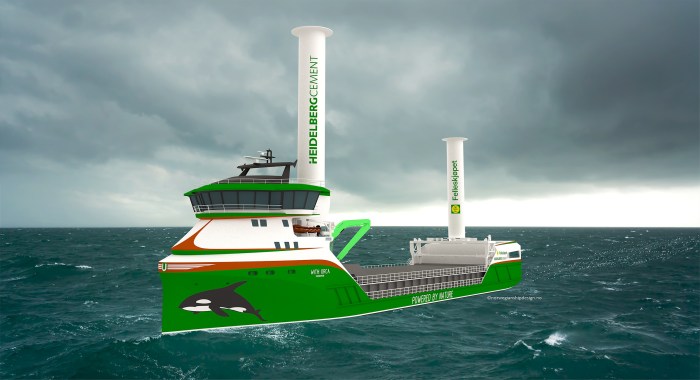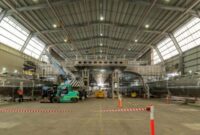Zero emissions cargo shipping the old fashioned way – it might sound like a paradox, but in a world grappling with climate change, the idea of harnessing the wind to move goods across oceans is gaining momentum. As the demand for sustainable shipping solutions grows, the environmental impact of traditional cargo vessels, with their reliance on fossil fuels, becomes increasingly concerning.
This shift towards a greener future is prompting a resurgence of interest in a technology that has been around for centuries: sail-powered cargo ships.
While modern shipping has relied heavily on powerful engines and complex logistics, there’s a growing realization that the simplicity and efficiency of sail power could hold the key to a more sustainable future for cargo transportation. The potential of sail-powered ships to reduce emissions, cut costs, and offer a more environmentally friendly alternative is attracting attention from both industry leaders and environmental advocates.
The Rise of Sustainable Shipping
The global demand for goods is soaring, and with it, the need for efficient and sustainable cargo transportation solutions. The traditional methods of cargo shipping, while effective, have a significant environmental impact. This has spurred the rise of sustainable shipping, a movement focused on reducing the carbon footprint of maritime trade.
The Environmental Impact of Traditional Cargo Shipping, Zero emissions cargo shipping the old fashioned way
Traditional cargo shipping methods, primarily relying on fossil fuels, contribute significantly to greenhouse gas emissions, air pollution, and ocean acidification. These methods are responsible for approximately 3% of global greenhouse gas emissions, and this number is expected to increase as global trade grows.
“Shipping is a major contributor to climate change, accounting for about 3% of global greenhouse gas emissions.”
International Maritime Organization (IMO)
Zero-Emission Cargo Shipping Initiatives
The shipping industry is actively pursuing innovative solutions to reduce its environmental impact. Here are some examples of zero-emission cargo shipping initiatives:
- Electric Cargo Ships:Several companies are developing and deploying electric cargo ships, powered by batteries or fuel cells. These vessels offer zero-emission operation in port areas, reducing local air pollution and noise. For example, the Yara Birkeland, a fully electric cargo ship, operates in Norway, transporting fertilizer between a factory and a port.
- Wind-Powered Cargo Ships:Wind-powered cargo ships, such as those equipped with sails or rotor sails, harness the power of the wind to propel the vessel, reducing reliance on fossil fuels. The “Viking Energy” is an example of a cargo ship that utilizes a combination of wind power and conventional engines, achieving significant fuel savings and emission reductions.
- Biofuels:Biofuels, derived from renewable sources like algae or waste products, can be used as a sustainable alternative to fossil fuels in cargo ships. The “Maersk Mc-Kinney Møller,” the world’s largest container ship, has successfully completed a trial run using biofuel, demonstrating the potential of this technology.
- Hydrogen-Powered Cargo Ships:Hydrogen fuel cells offer a promising alternative for powering cargo ships, generating electricity from hydrogen and oxygen without emitting greenhouse gases. The “MS Energy Observer,” a hydrogen-powered vessel, has been sailing around the world, showcasing the feasibility of this technology.
Reimagining Traditional Shipping Methods
In the quest for sustainable shipping solutions, the focus has largely been on modern technologies like electric vessels and biofuels. However, a potent solution might lie in revisiting a method that has been around for centuries: sail power. Sail-powered cargo ships, while seemingly antiquated, hold significant potential for reducing emissions in the modern shipping industry.
The Potential of Sail-Powered Cargo Ships
Sail-powered cargo ships, often referred to as “wind-assisted vessels,” offer a compelling alternative to traditional fuel-powered vessels. By harnessing the power of wind, these ships can significantly reduce their reliance on fossil fuels, contributing to a cleaner and more sustainable shipping industry.The use of sail power is not a novel concept.
For centuries, sailing ships dominated the seas, transporting goods across vast distances. However, the advent of steam-powered ships in the 19th century gradually replaced sail power as the dominant mode of transportation. While modern technology has advanced significantly since then, the fundamental principles of sailing remain unchanged.
The ability of wind to propel a ship is a natural and renewable resource, offering a viable solution for reducing greenhouse gas emissions in the shipping industry.
Efficiency of Sail-Powered Ships
The efficiency of sail-powered ships is a complex issue that depends on several factors, including the size and design of the vessel, the wind conditions, and the route being traveled.
- Energy Efficiency:Sail-powered ships can achieve significantly higher energy efficiency compared to traditional fuel-powered vessels, particularly in favorable wind conditions. This is because wind power is a free and renewable energy source, eliminating the need for fuel consumption. Studies have shown that sail-powered ships can achieve fuel savings of up to 50% compared to conventional vessels.
- Operational Costs:The reduced fuel consumption translates into lower operational costs for sail-powered ships. This cost savings can be significant, particularly in the long term, as fuel prices continue to fluctuate.
- Environmental Impact:Sail-powered ships have a significantly lower environmental impact compared to traditional vessels. By eliminating or reducing fuel consumption, they contribute to reducing greenhouse gas emissions and air pollution.
Design of a Hypothetical Sail-Powered Cargo Ship
Imagine a modern cargo ship designed to incorporate the power of wind. This vessel would feature a large, efficient sail system that could be deployed and retracted depending on wind conditions. The sail system would be designed to maximize wind capture and minimize drag, ensuring optimal performance.
- Advanced Sail Technology:The sail system would incorporate advanced technologies, such as computer-controlled deployment and retraction mechanisms, as well as adaptive sail shapes that optimize performance based on wind conditions. This would allow the ship to navigate efficiently in a wide range of weather conditions.
- Hybrid Propulsion:The ship would also be equipped with a hybrid propulsion system, combining sail power with a conventional engine for greater flexibility and reliability. This would ensure that the ship could maintain its course and speed even in low-wind conditions.
- Optimized Hull Design:The hull design would be optimized for efficiency, minimizing drag and maximizing speed. This would further enhance the ship’s performance and fuel efficiency, even when relying on the conventional engine.
The integration of advanced sail technology, hybrid propulsion, and optimized hull design would create a modern, efficient, and environmentally friendly cargo ship capable of reducing emissions and operating costs while maintaining reliability and flexibility.
Technological Advancements in Sail Technology

The revival of sail technology in cargo shipping is not simply a return to the past; it’s a testament to the innovative advancements in sail design and materials that are making wind-powered vessels more efficient and commercially viable than ever before.
These advancements are pushing the boundaries of what’s possible, turning sails from a relic of the past into a key player in the future of sustainable shipping.
Advancements in Sail Design and Materials
The traditional image of a simple canvas sail is being replaced by sophisticated designs and high-performance materials that significantly improve efficiency and durability.
- Rotors and Flettner Rotors:These cylindrical sails, resembling giant spinning drums, harness the Magnus effect, where a rotating cylinder creates lift in a moving fluid. This technology allows for efficient wind capture even in light winds, making it particularly suitable for low-wind regions.
- Wing Sails:These rigid, airfoil-shaped sails, similar to airplane wings, are designed to capture more wind energy and provide greater stability than traditional sails. Their rigid structure allows them to operate effectively in a wider range of wind conditions and can be easily adjusted for optimal performance.
- High-Tech Materials:Modern sails are constructed from advanced materials like lightweight, high-strength composites and durable fabrics, allowing for greater efficiency, longevity, and reduced maintenance costs. These materials are also resistant to weathering and UV degradation, extending the lifespan of the sails.
Check nuclear power startups flourishing europe heres what they can offer to inspect complete evaluations and testimonials from users.
Innovative Sail Technologies in Modern Vessels
Several innovative sailing vessels are pushing the boundaries of wind-powered shipping, showcasing the potential of this technology.
- The “Flying” Yacht:The Maltese Falcon, a superyacht with three rotating masts and 15 sails, is a prime example of the use of advanced sail technology. Its wing-like sails allow it to “fly” over the water, reaching speeds comparable to motor yachts.
- The “Wind-Powered Cargo Ship”:The “Beluga SkySails,” a German cargo ship equipped with a 150-meter-tall kite sail, demonstrates the potential of wind energy harvesting for large cargo vessels. The kite sail, tethered to the ship, generates substantial thrust, reducing fuel consumption and emissions.
- The “Hybrid Sail-Powered Vessel”:The “E-Ship 1,” a hybrid cargo ship designed by the German company E-Ship, combines wind propulsion with electric motors, enabling efficient and sustainable operation. This hybrid approach offers flexibility and adaptability, allowing for efficient operation even in low-wind conditions.
Potential of Wind Energy Harvesting for Powering Cargo Ships
The potential of wind energy harvesting for powering cargo ships is vast, with numerous advantages over traditional fuel-based methods.
- Reduced Fuel Consumption:Wind-powered vessels can significantly reduce fuel consumption, leading to lower operational costs and reduced emissions.
- Reduced Emissions:By relying on renewable wind energy, wind-powered vessels contribute to a cleaner and more sustainable shipping industry, reducing greenhouse gas emissions and promoting environmental protection.
- Increased Efficiency:Modern sail technologies are designed to capture and utilize wind energy efficiently, making wind-powered vessels a viable alternative to traditional fuel-powered ships.
Economic Feasibility of Sail-Powered Cargo Shipping: Zero Emissions Cargo Shipping The Old Fashioned Way
The potential of sail-powered cargo ships to reduce emissions and contribute to a sustainable future is undeniable. However, the economic viability of this technology is a critical factor in its widespread adoption. This section delves into the cost-effectiveness of sail-powered cargo ships compared to traditional vessels, explores potential challenges and opportunities associated with adopting this technology, and presents a comprehensive analysis of the economic feasibility of sail-powered cargo shipping.
Cost-Effectiveness of Sail-Powered Cargo Ships
The cost-effectiveness of sail-powered cargo ships is a complex issue that depends on various factors, including ship design, route, cargo type, and fuel prices. While sail-powered ships offer significant fuel savings, their initial investment costs can be higher than traditional vessels.
- Fuel Savings:Sail-powered ships rely primarily on wind energy, reducing their reliance on fossil fuels. This translates to significant fuel cost savings, particularly on long-distance routes where wind power is abundant.
- Reduced Maintenance Costs:Sail-powered ships have fewer moving parts compared to traditional vessels, potentially leading to lower maintenance costs over their lifespan.
- Initial Investment Costs:The initial investment costs of sail-powered ships can be higher due to the complex engineering required for sail design and integration. However, these costs are offset by the long-term fuel savings and reduced maintenance expenses.
Challenges and Opportunities of Sail-Powered Cargo Shipping
The adoption of sail-powered cargo shipping faces several challenges and opportunities.
- Infrastructure and Port Compatibility:Existing port infrastructure may not be adequately equipped to handle sail-powered ships, requiring investments in specialized berths and handling equipment.
- Route Optimization and Scheduling:Sail-powered ships are reliant on wind patterns, which can impact route planning and delivery schedules. Advanced route optimization algorithms and weather forecasting tools are crucial to ensure reliable and timely deliveries.
- Regulatory Framework:Clear regulatory frameworks and incentives are essential to encourage the adoption of sail-powered cargo shipping. Governments and maritime authorities play a crucial role in promoting this technology through policies and regulations.
- Public Awareness and Market Demand:Raising public awareness about the benefits of sail-powered cargo shipping is vital to increase market demand and encourage investment in this technology.
Economic Feasibility Analysis
The economic feasibility of sail-powered cargo shipping can be analyzed through a comparative assessment of its costs and benefits.
| Factor | Sail-Powered Cargo Shipping | Traditional Cargo Shipping |
|---|---|---|
| Fuel Costs | Significantly lower due to reliance on wind energy | Higher due to dependence on fossil fuels |
| Maintenance Costs | Potentially lower due to fewer moving parts | Higher due to complex machinery and systems |
| Initial Investment Costs | Higher due to advanced engineering and sail design | Lower for traditional vessel construction |
| Environmental Impact | Zero emissions, contributing to sustainability | Significant emissions contributing to climate change |
| Operational Efficiency | Dependent on wind patterns, impacting route planning and schedules | More predictable and reliable schedules |
The Future of Zero-Emission Cargo Shipping
The future of cargo shipping is inextricably linked to sustainability. As the global economy continues to grow, so too does the demand for efficient and environmentally friendly transportation solutions. Sail-powered cargo ships represent a compelling solution to this challenge, offering a path towards a zero-emission future.
The Role of Sail-Powered Cargo Ships in Achieving a Sustainable Future
Sail-powered cargo ships offer a compelling alternative to traditional fossil fuel-powered vessels, significantly reducing greenhouse gas emissions. They leverage the power of the wind, a renewable and readily available energy source, to propel themselves across the oceans. By harnessing this natural force, sail-powered ships contribute to a cleaner and more sustainable maritime industry.
Potential Advancements in Sail Technology
Advancements in sail technology are crucial for further reducing emissions and enhancing the efficiency of sail-powered cargo ships.
- Automated sail systems: These systems can adjust sail configurations based on wind conditions, optimizing performance and reducing reliance on human intervention.
- Wing sails: These rigid, aerodynamic sails are designed to capture more wind energy, offering greater efficiency compared to traditional sails.
- Hybrid propulsion systems: Combining sail power with electric or fuel-efficient engines allows for greater flexibility and adaptability in diverse wind conditions.
Factors Driving the Adoption of Zero-Emission Cargo Shipping
Several factors are driving the adoption of zero-emission cargo shipping, including:
- Growing environmental concerns: Increasing awareness of climate change and the need for sustainable transportation solutions is driving demand for greener shipping options.
- Stricter regulations: Governments worldwide are implementing stricter emissions regulations for the maritime industry, incentivizing the adoption of zero-emission technologies.
- Economic benefits: Sail-powered cargo ships offer potential cost savings through reduced fuel consumption and lower maintenance costs.
- Technological advancements: Continuous improvements in sail technology and hybrid propulsion systems are making sail-powered cargo shipping more viable and competitive.
- Consumer demand: Consumers are increasingly demanding environmentally responsible products and services, putting pressure on businesses to adopt sustainable practices, including transportation.




